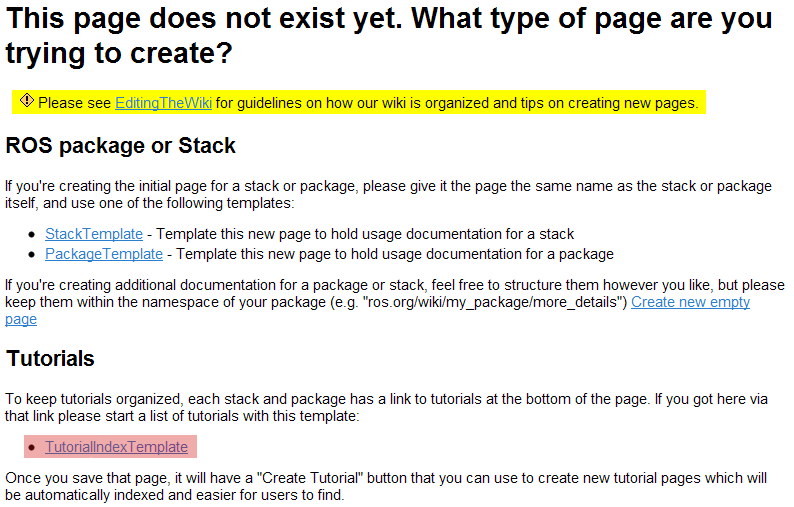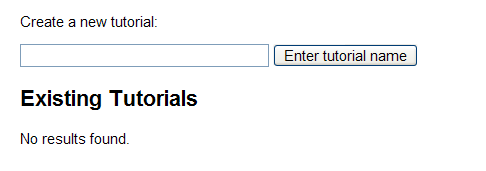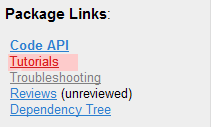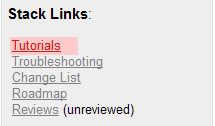QAProcess: DevelopersGuide | Review Status | PackageProposalProcess | PackageDocumentation | APIReviewProcess | DocReviewProcess | CodeReviewProcess | StackDocumentation | StackVersionPolicy | AutomatedTesting | StackReleaseProcess | WritingTutorials | Graveyard
| Note: 在写教程前请花时间看看ROS教程。. |
| |
如何编写教程
Description: (概述:)本教程介绍在编辑ros.org维基时可以用到的模板和宏定义,并附有示例以供参考。Keywords: teaching, tutorials, writing, 教程, 编辑, 维基, 学习
Tutorial Level: BEGINNER
Contents
如何开始
在写教程之前,先浏览一下您的教程所在页面。如果这个页面没有被占用,那么此页面就会显示为“不存在的维基”页面(non-existent /Tutorials wiki page)。
一旦您打开这个“不存在的维基”页面,您将会被重定向到如下界面:

单击“TutorialIndexTemplate”链接并保存默认的预览模板,您就可以创建一个如下的新页面:

这个页面对创建您的教程非常有用,同时也会显示一个当前教程的列表。 在栈或包的介绍页面的边栏中会创建一个如下的教程链接:
|
|
创建一个教程
在新建教程框(Create a new tutorial)中输入您教程的名字并单击“Enter tutorial name”按钮创建一个基于TutorialTemplate的页面(一些关键字前会显示 ! 符号,使用时请去掉它们):
####################################
##FILL ME IN
####################################
## for a custom note with links:
## !note =
## for the canned note of "This tutorial assumes that you have completed the
## previous tutorials:" just add the links
## !note.0.link=
## descriptive title for the tutorial
## !title =
## multi-line description to be displayed in search
## !description =
## the next tutorial description (optional)
## !next =
## links to next tutorial (optional)
## !next.0.link=
## !next.1.link=
## what level user is this tutorial for
## !level= (BeginnerCategory, IntermediateCategory, AdvancedCategory)
## !keywords =
####################################
!<<IncludeCSTemplate(TutorialCSHeaderTemplate)>>
请注意保存您的页面,因为预览按钮(preview)有事不能正常地工作。
填写模板头信息
上面展示的模板是系统自动生成的文档头信息。效果与本教程的开头类似。现在我们来一起看看这些模板是如何工作的。
提醒
“提示”(note)标签可以生成类似于页面顶部的蓝色提醒框,以用来提示用户如何遵循您的教程。
向其中填写的内容将会生成如下效果:
note= 狂拽炫酷吊炸天。
Note: 狂拽炫酷吊炸天。 |
又如,您可以使用下列关键字:
note.0=[[ROS/Tutorials|ROS教程]] note.1=[[Documentation| ros.org]]
这样就可以为您的教程添加一个标准的前导教程提示:This tutorial assumes that you have completed the previous tutorials:(本教程假设您已经完成且掌握了下列教程的内容:)
请注意,如果您想在您的自定义提示中加入链接,您可以直接在note标签中包含这个链接而不是单独使用 note.0, note.1等标签单独标记链接。如果您错误的使用了note.0, note.1等标签以下提示内容可能会错误的出现在您的链接前:"This tutorial assumes that you have completed the previous tutorials:"
标题
“标题”(title)标签可以创建页面开头的标题,同时它也标记了您教程的标题。教程标题将出现在搜索结果中。
!title= 风骚但不失矜持的名字很重要
概述
“概述”(description)标签会在您的页面顶端显示您的教程概述,此概述也会出现在搜索结果中。
description= 我的葵花宝典狂拽炫酷吊炸天,还不快来试试!
效果如下:
Description: 我的葵花宝典狂拽炫酷吊炸天,还不快来试试! |
后续
“后续”(next)标签用于显示完成您当前教程之后可以继续学习的其他教程。这个标签是可选的,如果空下将不会显示任何内容。
next=练完葵花宝典的亲们还可以看看 next.0.link=[[ROS/Tutorials|ROS教程]] next.1.link=[[actionlib_tutorials/Tutorials|actionlib教程]]
效果如下:
Next Tutorial: 练完葵花宝典的亲们还可以看看ROS教程 actionlib教程. |
您也可以这样使用:
next.0.link=[[actionlib_tutorials/Tutorials|Actionlib教程]]
效果如下:
Next Tutorial: Actionlib教程. |
等级
“等级”(level)标签有双重意义,它不但告诉用户您的教程需要他们达到什么水平,而且也是教程搜索引擎的分类标准之一。 BeginnerCategory:初级 IntermediateCategory:中级 AdvancedCategory:高级
level=AdvancedCategory
效果如下:
Tutorial Level: ADVANCED |
关键字
“关键字”(keywords)标签可以帮助用户通过关键字找到您的教程。
keywords= 狂拽, 炫酷, 吊炸天
效果如下:
Keywords: 狂拽, 炫酷, 吊炸天 |
实用宏命令
ROS维基提供了许多有用的宏命令以帮助您更好的完成您的教程。
代码显示框
目前ROS维基支持以下语言的代码提示框:
c++
- 示例:
{{{ #!cplusplus #include <ros/ros.h> int main(int argc, char** argv) { ros::init(argc, argv, "talker"); ros::NodeHandle n; ... }}}
latex
- 示例:
{{{ #!latex $$\overline{\overline{J}} \dot{\overline{v}} = -\overline{k}$$ }}}
latex error! exitcode was 1 (signal 0), transscript follows: This is pdfTeX, Version 3.14159265-2.6-1.40.19 (TeX Live 2018) (preloaded format=latex) kpathsea: Running mktexfmt latex.fmt mktexfmt: mktexfmt is using the following fmtutil.cnf files (in precedence order): mktexfmt: /usr/share/texlive/texmf-dist/web2c/fmtutil.cnf mktexfmt: mktexfmt is using the following fmtutil.cnf file for writing changes: mktexfmt: /usr/share/httpd/.texlive2018/texmf-config/web2c/fmtutil.cnf /usr/bin/mktexfmt: mkdir(/usr/share/httpd/.texlive2018/) failed: Permission denied I can't find the format file `latex.fmt'!
python
- 示例:
{{{ #!python #!/usr/bin/env python import roslib; roslib.load_manifest('beginner_tutorials') import rospy from std_msgs.msg import String def talker(): pub = rospy.Publisher('chatter', String) rospy.init_node('talker', anonymous=True) ... }}}
CodeRef
在您编写教程的过程中,您有时可能会引用到您之前所写的代码块。这时,您可以使用“CodeRef”引用它们。
{{{
#!cplusplus block=blockname
葵花宝典....
不但 高端大气上档次
而且 狂拽炫酷吊炸天
}}}你可以使用“CodeRef”宏来引用上面代码块的特定行:
<<CodeRef(blockname,1,2)>>
效果如下:
FullSearchWithDescriptionsCS
“FullSearchWithDescriptionsCS”宏可以根据关键字自动生成教程索引和搜索结果。
<<FullSearchWithDescriptionsCS(title:WritingTutorials BeginnerCategory)>>
这条代码用来显示标题为“WritingTutorials”且分类为“BeginnerCategory”的教程的标题及概述。如果将分类改为“AdvancedCategory”,将没有任何显示结果。
- How to Write a Tutorial
This tutorial covers useful template and macros for writing tutorials, along with example tutorials that are available for guidance on ros.org
- Como escrever um tutorial
This tutorial covers useful template and macros for writing tutorials, along with example tutorials that are available for guidance on ros.org
- 如何编写教程
(概述:)本教程介绍在编辑ros.org维基时可以用到的模板和宏定义,并附有示例以供参考。
- チュートリアルの書き方
このチュートリアルはros.orgに関するガイダンスのために利用できるサンプルチュートリアルにそってチュートリアルを記述するための便利なテンプレートとマクロを押さえます。
- 튜토리얼 작성하기
이 튜토리얼은 튜토리얼 작성을 위한 튜토리얼입니다.
IncludeCSTemplate
这个宏将页面顶端的关键字转换为clearsilver变量,这些变量可以被clearsilver模板命令使用。本教程中的关键字被用在TutorialCSHeaderTemplate中
!<<IncludeCSTemplate(TutorialCSHeaderTemplate)>>
嵌入视频
这个宏可以在本维基中添加视频。将您的视频文献上传至Youtube夹并使用这个宏命令指向您的视频路径就可在您的教程中添加视频。
注意: MediaServer宏已停止使用,所以你必须重新上传你的视频。
这个例子演示了一个在wge100_camera文件夹中的视频。
<<Youtube(Q5KC-trrw_o)>>
示例教程
以下列出了一些优秀的教程共您参考(英文):
共同建设ROS中文社区,请联系我。ZhiweiChu









